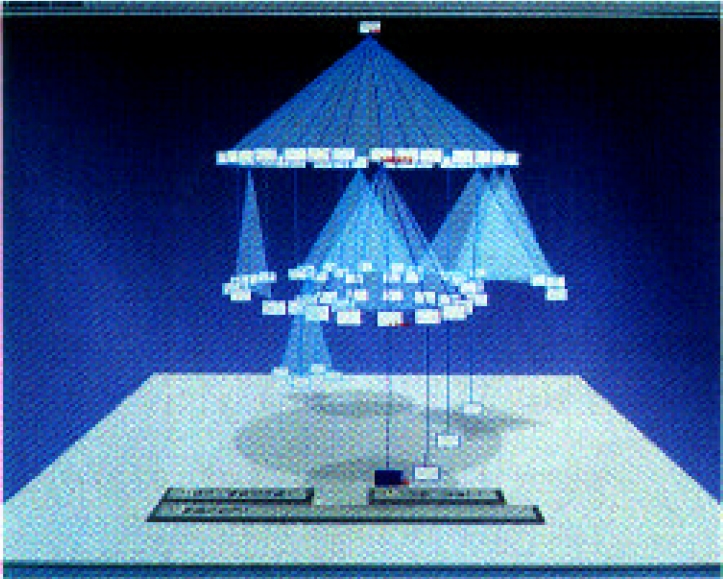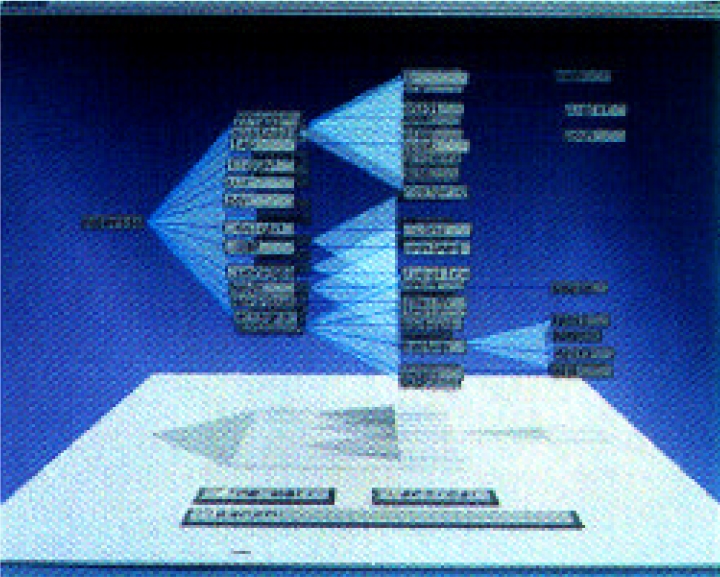Teaching:TUW - UE InfoVis WS 2008/09 - Gruppe 03 - Aufgabe 1 - Cone Tree: Difference between revisions
(New page: == Introduction == {{Quotation| ... the Cone Tree, which is used for visualizing hierarchical information structures.|[Robertson et al., 1991]}} Cone Trees are a suitable visualization t...) |
(critics and references update) |
||
| Line 24: | Line 24: | ||
== Critics == | == Critics == | ||
A study showed that subjects were significantly slower at locating named files in a hierarchical data structure when using a cone tree interface than when using a 'normal' tree interface. [Cockburn and Mckenzie, 2000] | A study showed that subjects were significantly slower at locating named files in a hierarchical data structure when using a cone tree interface than when using a 'normal' tree interface. [Cockburn and Mckenzie, 2000] | ||
And Cone Trees "seem to inherit a problem of standard node-link diagrams: they fall short when it comes to large trees. Treemaps [Shneiderman, 1992] were invented by shneiderman to address this particular problem."[VanWijk et al., 2003] | |||
== References == | == References == | ||
* [Robertson et al., 1991] George Robertson, Jock D. Mackinlay, Stuart Card. Cone Trees: Animated 3D Visualizations of Hierarchical Information. In Proceedings of the ACM CHI 91 Human Factors in Computing Systems Conference, pages 189-- 194, April 28 - June 5, 1991, New Orleans, Louisiana, June 1991. Association for Computing Machinery | * [Robertson et al., 1991] George Robertson, Jock D. Mackinlay, Stuart Card. Cone Trees: Animated 3D Visualizations of Hierarchical Information. In Proceedings of the ACM CHI 91 Human Factors in Computing Systems Conference, pages 189-- 194, April 28 - June 5, 1991, New Orleans, Louisiana, June 1991. Association for Computing Machinery | ||
* [Cockburn and Mckenzie, 2000] Andy Cockburn, Bruce Mckenzie. An Evaluation of Cone Trees. In ''People and Computers XIV: British Computer Society Conference on Human Computer Interaction 2000'', p425--436. Springer-Verlag. | * [Cockburn and Mckenzie, 2000] Andy Cockburn, Bruce Mckenzie. An Evaluation of Cone Trees. In ''People and Computers XIV: British Computer Society Conference on Human Computer Interaction 2000'', p425--436. Springer-Verlag. | ||
* [Shneiderman, 1992] Ben Shneiderman. Tree visualization with tree-maps: A 2-D space-filling approach. ACM Transactions on Graphics 11, pages 92--99, 1992. Association for Computing Machinery | |||
* [VanWijk et al., 2003] Jarke J. van Wijk, Frank Van Ham, Huub Van De Wetering. Rendering Hierarchical Data. Communications of the ACM, pages 257--263, 2003. Association for Computing Machinery | |||
Revision as of 23:15, 7 November 2008
Introduction
Cone Trees are a suitable visualization technique for dealing with a great amount of information in hierachichal struture, with the aim to display and navigate through the information in an intuitative manner. On screens a 2D layout of such structures wouldn't be easy to handle with. It would not fit on the screen and "The user would have to either scroll through the layout or use a size-reduced image of the structure."

[Robertson et al., 1991]
The root node is placed at the apex of the cone tree. All children nodes are placed at equal distances along the base. This process is repeated for every following level.
For navigation the user can rotate the cone and choose a special node, which is shown with an animation.

[Robertson et al., 1991]
Critics
A study showed that subjects were significantly slower at locating named files in a hierarchical data structure when using a cone tree interface than when using a 'normal' tree interface. [Cockburn and Mckenzie, 2000] And Cone Trees "seem to inherit a problem of standard node-link diagrams: they fall short when it comes to large trees. Treemaps [Shneiderman, 1992] were invented by shneiderman to address this particular problem."[VanWijk et al., 2003]
References
- [Robertson et al., 1991] George Robertson, Jock D. Mackinlay, Stuart Card. Cone Trees: Animated 3D Visualizations of Hierarchical Information. In Proceedings of the ACM CHI 91 Human Factors in Computing Systems Conference, pages 189-- 194, April 28 - June 5, 1991, New Orleans, Louisiana, June 1991. Association for Computing Machinery
- [Cockburn and Mckenzie, 2000] Andy Cockburn, Bruce Mckenzie. An Evaluation of Cone Trees. In People and Computers XIV: British Computer Society Conference on Human Computer Interaction 2000, p425--436. Springer-Verlag.
- [Shneiderman, 1992] Ben Shneiderman. Tree visualization with tree-maps: A 2-D space-filling approach. ACM Transactions on Graphics 11, pages 92--99, 1992. Association for Computing Machinery
- [VanWijk et al., 2003] Jarke J. van Wijk, Frank Van Ham, Huub Van De Wetering. Rendering Hierarchical Data. Communications of the ACM, pages 257--263, 2003. Association for Computing Machinery